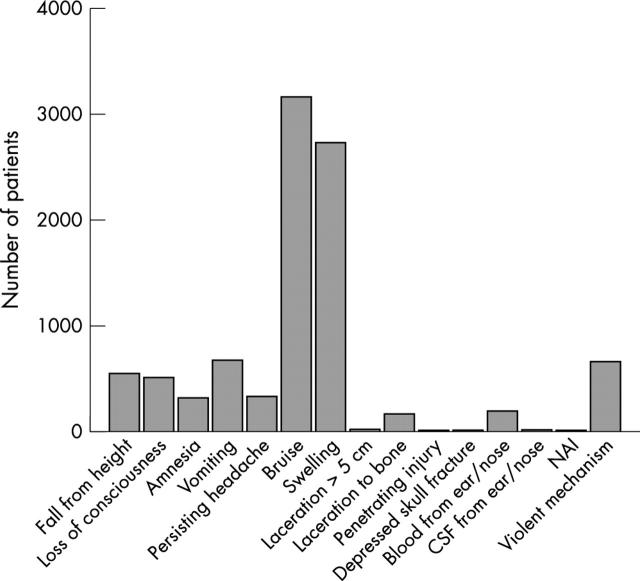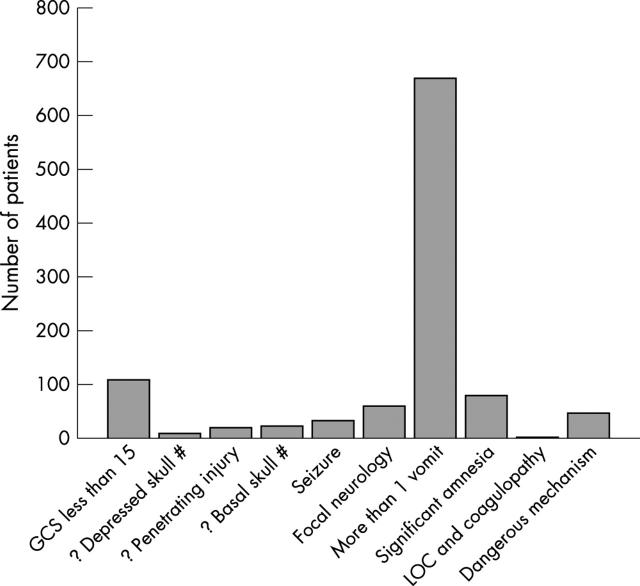Abstract
Background: NICE guidelines for the management of head injury were published in June 2003. Their recommendations differ markedly from previous guidelines published by the Royal College of Surgeons (RCS). In place of skull radiography and admission, computed tomography (CT) is advocated. The impact of these guidelines on service provision in the UK is unknown.
Methods: Data on all clinical correlates of children presenting with any severity of head injury was collected in three hospitals in the northwest of England. The current skull radiograph (SXR), CT scan, and admission rates were determined. The rates of SXR, CT scan, and admission that should have occurred when following either the RCS or NICE guidelines were then determined.
Results: Data from 10 965 patients who attended three hospitals between February 2000 and August 2002 was studied. Twenty five per cent of patients received a SXR, 0.9% a CT scan, and 3.7% were admitted. Strict adherence to the RCS guidelines would have resulted in a 50% SXR rate, a 1.6% CT scan rate, and a 7.1% admission rate. Adherence to NICE guidelines would result in a 0.3% SXR rate, an 8.7% CT scan rate, and a 1.4% admission rate, although the CT rate would drop to 6.3% if vomiting three or more times in the under 12s was used instead of more than one vomit.
Conclusions: The new NICE guidelines do not increase the workload caused by patients attending with head injury but they move their management from the observation ward to the radiology department.
Full Text
The Full Text of this article is available as a PDF (124.4 KB).
Figure 1.
SXR required by RCS guidelines 1999.
Figure 2.
Reasons for a CT under NICE guidelines. #, fracture; ?, query.
Selected References
These references are in PubMed. This may not be the complete list of references from this article.
- Borczuk P. Predictors of intracranial injury in patients with mild head trauma. Ann Emerg Med. 1995 Jun;25(6):731–736. doi: 10.1016/s0196-0644(95)70199-0. [DOI] [PubMed] [Google Scholar]
- Boulis Z. F., Dick R., Barnes N. R. Head injuries in children--aetiology, symptoms, physical findings and x-ray wastage. Br J Radiol. 1978 Nov;51(611):851–854. doi: 10.1259/0007-1285-51-611-851. [DOI] [PubMed] [Google Scholar]
- Brookes M., MacMillan R., Cully S., Anderson E., Murray S., Mendelow A. D., Jennett B. Head injuries in accident and emergency departments. How different are children from adults? J Epidemiol Community Health. 1990 Jun;44(2):147–151. doi: 10.1136/jech.44.2.147. [DOI] [PMC free article] [PubMed] [Google Scholar]
- Gorman D. F. The utility of post-traumatic skull X-rays. Arch Emerg Med. 1987 Sep;4(3):141–150. doi: 10.1136/emj.4.3.141. [DOI] [PMC free article] [PubMed] [Google Scholar]
- Haydel M. J., Preston C. A., Mills T. J., Luber S., Blaudeau E., DeBlieux P. M. Indications for computed tomography in patients with minor head injury. N Engl J Med. 2000 Jul 13;343(2):100–105. doi: 10.1056/NEJM200007133430204. [DOI] [PubMed] [Google Scholar]
- Jennett B., MacMillan R. Epidemiology of head injury. Br Med J (Clin Res Ed) 1981 Jan 10;282(6258):101–104. doi: 10.1136/bmj.282.6258.101. [DOI] [PMC free article] [PubMed] [Google Scholar]
- Lloyd D. A., Carty H., Patterson M., Butcher C. K., Roe D. Predictive value of skull radiography for intracranial injury in children with blunt head injury. Lancet. 1997 Mar 22;349(9055):821–824. doi: 10.1016/S0140-6736(96)09356-7. [DOI] [PubMed] [Google Scholar]
- Miller E. C., Holmes J. F., Derlet R. W. Utilizing clinical factors to reduce head CT scan ordering for minor head trauma patients. J Emerg Med. 1997 Jul-Aug;15(4):453–457. doi: 10.1016/s0736-4679(97)00071-1. [DOI] [PubMed] [Google Scholar]
- Nee P. A., Hadfield J. M., Yates D. W., Faragher E. B. Significance of vomiting after head injury. J Neurol Neurosurg Psychiatry. 1999 Apr;66(4):470–473. doi: 10.1136/jnnp.66.4.470. [DOI] [PMC free article] [PubMed] [Google Scholar]
- Servadei F., Teasdale G., Merry G., Neurotraumatology Committee of the World Federation of Neurosurgical Societies Defining acute mild head injury in adults: a proposal based on prognostic factors, diagnosis, and management. J Neurotrauma. 2001 Jul;18(7):657–664. doi: 10.1089/089771501750357609. [DOI] [PubMed] [Google Scholar]
- Stiell I. G., Wells G. A., Vandemheen K., Clement C., Lesiuk H., Laupacis A., McKnight R. D., Verbeek R., Brison R., Cass D. The Canadian CT Head Rule for patients with minor head injury. Lancet. 2001 May 5;357(9266):1391–1396. doi: 10.1016/s0140-6736(00)04561-x. [DOI] [PubMed] [Google Scholar]
- Swann I. J., MacMillan R., Strong I. Head injuries at an inner city accident and emergency department. Injury. 1981 Jan;12(4):274–278. doi: 10.1016/0020-1383(81)90200-x. [DOI] [PubMed] [Google Scholar]
- Teasdale G. M. Head injury. J Neurol Neurosurg Psychiatry. 1995 May;58(5):526–539. doi: 10.1136/jnnp.58.5.526. [DOI] [PMC free article] [PubMed] [Google Scholar]
- de Lacey G., McCabe M., Constant O., Welch T., Spinks C., McNally E. Testing a policy for skull radiography (and admission) following mild head injury. Br J Radiol. 1990 Jan;63(745):14–18. doi: 10.1259/0007-1285-63-745-14. [DOI] [PubMed] [Google Scholar]




